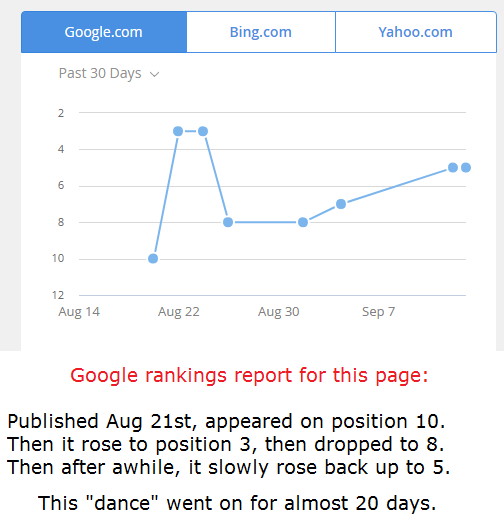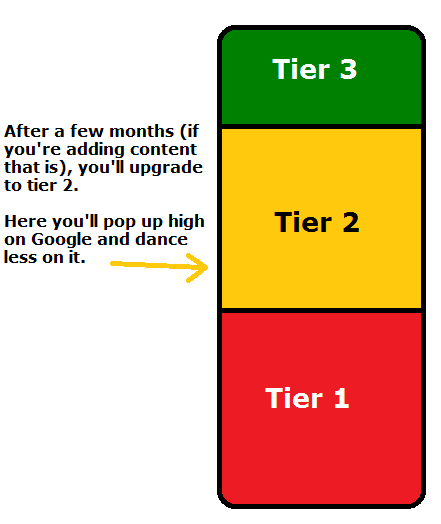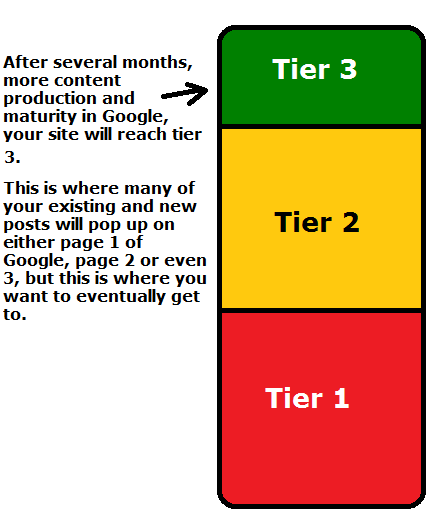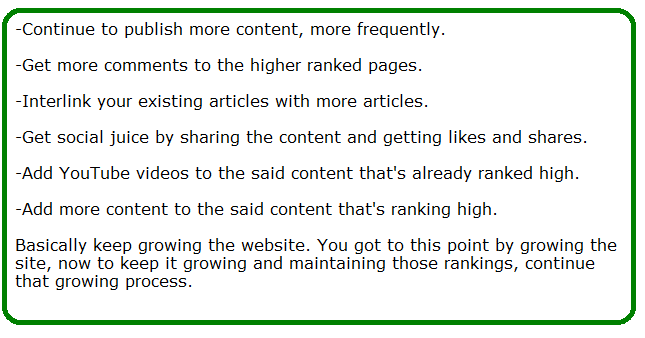I used to despise the Google dance, but with all the experience and knowledge I’ve attained in SEO since then, it has made me appreciate it, for how brilliant of a system it is.
This is the game changer in SEO and it allows anyone who starts a new site to grow and defeat existing, big sites basically. You’re going to understand this more and more as you read this article and appreciate it too afterwards.
Most importantly, because of all the knowledge I’ve gathered, I’ve understood how to use this very system to improve my SEO rankings and I will teach you to do the same stuff for your site.
This article is for people:
- Who don’t understand why this bouncing of your site is happening.
- Who need to know how to break the dance and solidify higher rankings.
- Who are frustrated by the Google dance and can’t get any high rankings because of it (it’s actually not because of that but is because of other factors).
After you read this article, you will reignite your SEO efforts and truly succeed.
Contents
New to the term “Google Dance”? No worries, here’s what you need to know:
The Google dance is basically a “filtration” process that happens every time a new page or blog post is published on ANY website, in the world.
That filtration process is basically a period where that new page or blog post “bounces” around Google’s search results.
Here is an example:

Here’s another example. in which I published a post on one of my other websites and through using a special keyword tool, I was able to track it’s rankings. Look at how they bounce all around day after day:

The following keyword I was seeking to rank for started in the first page position, climbed, then dropped, stagnated and then lowly rose back up again. This is honestly not a big deal, because most of this bouncing was happening on the first page, but most people don’t experience this, that high up in rankings (but I’ll show you how to get there below).
I know how frustrating that can seem, but believe me on this…
If you are seeking to rank in Google, your site and the content you publish HAS to go through this thing (and it’s OK). It also has to go through the Google sandbox, which is also a brilliant SEO process.
Why the Google Dance is a brilliant invention:
Let me give you a very simple analogy that explains why this system HAS to exist:
-Let’s imagine a person who is doing SEO for his site. His name is Bob.
-Bob publishes an article on his blog titled “how to lose weight by eating veggies”. He wants to have that article rank on the first page or at least on the first 10 search results (that’s still the first page). Anyone who gets into SEO does so for that purpose:
To rank on the first page, that’s where the money is at.
-Google comes along, crawls, picks up Bob’s article and begins ranking it for that very same title.
-However, in this circumstance, there’s other people (let’s say 20 other bloggers) with their own versions of this same title and article, also competing to hit that first page ranking, aka people competing against Bob.
-How does Google decide which of the 21 (the 20 competitors + Bob all writing about the same stuff) gets the first spot and how the other 20 are organized in it’s search result?
Simple…
It runs them ALL through it’s dance system.
Each blog will have it’s OWN turn in that it’ll rank high for the said keyword I mentioned, then it’ll lose that position and another blog will then occupy that spot.
But is it just a turn taking process in the end or is there more? Oh there’s more and this is where there’s really GREAT news for you…
Revealing the secret inner workings of Google’s ranking algorithm:
Remember, it’s not just a turn taking game. Google is bouncing around all of those 21 blogs with intent in mind and here is that intent:
It wants to know which of those 21 blogs has the best content worth ranking high and gets the BEST feedback from the people who see it, click it, read it and more.
The blog which gets the best numbers is the one which gets the best result and sees the LEAST amount of dancing going on. And in my experience, having these 10 factors is what will give you those best numbers.
Let me explain:
-Let’s say out of those 21 blogs, 11 of them have horrible content. So when they get bounced around Google and people see them and click on them, they don’t stay around the site and leave it quickly.
Google RECORDS that info and the feedback to it is that those 11 blogs are NOT worthy of getting ranked high, therefore, they get pushed to the back of the line.
You see, the fact is, there is tracking an analytical data collection happening behind the scenes by this program. It’s happening on your site, it’s happening when people land on it and all of this is mixed and reported back to Google, which lets them know if you have high quality content or not.
-What remains is the other 10 blogs, and let’s say they all have good content and people click it, and stick around, reading the actual blog.
-Google records that and determines those 10 blogs deserve higher rankings so it’ll place them on the first page.
-But then there’s still competition going on. Yes those 10 blogs get the first page, but there’s still 10 positions. How does each of those blogs get organized in those 10 spots? Which get ranked higher? Which get ranked lower?
-Well Google just runs these 10 blogs through the same process.
-It’ll bounce those blogs around, but this time it’ll be in HIGHER positions (because they were already determined to be higher tier) and then based on the feedback those 10 blogs will get from people, Google will then organize those 10 blogs in the right order, where the ones with the best numbers/feedback from visitors will result in those blogs getting the higher positions.
This is why the dance exists and why again, I say it’s brilliant.
Another reason to appreciate it:
- Have you ever started a blog that was in a very competitive market?
- Have you ever thought that perhaps there’s too much competition and you can’t even get onto the first page?
Well if this is the case, then understand that the dance is here for help you. You can absolutely start a new blog and eventually beat out top 10 ranked blogs/pages through this process. In fact, I prove that with at least 5 sites of mine here.
Think about it this way…
My site is focused on SEO.
SEO is a VERY competitive market. There’s millions of blogs and articles all competing within it.
And considering this site is still new, why would I ever enter this market if I didn’t have a chance to beat the existing competition? I wouldn’t.
But because I know about the brilliance of the dance and how important content is for SEO, I can do it (and I will do it). In fact, I am already ranking for some awesome search terms and it’s still very early on in my website’s history, so these initial results are promising.
This system is designed to create a FAIR playing field. It’s what gives incentive for people with blogs to write great content.
The 3 tiers of the Google dance (And why you want to be in tier 3):
Tier 1:

When you have a new website and publish new content, it will generally see a much higher rate of bouncing around the search results when it seeks to rank on Google.
You will see rankings appear on page 20 or even further down. I’ve had rankings appear as low as page 10 (100th or lower search results).
This is OK.
But in this tier, people usually experience the most frustration and confusion, mainly because they don’t understand the SEO game and the dance, and expect first page rankings immediately.
This will NOT happen for tier 1 sites, it’ll only happen if you seek to rank for a keyword no one searches (but what’s the point then right?).
But once again, this is totally normal, OK and you should not get discouraged by your SEO efforts in this stage, you simply have to upgrade your website to tier 2 and here’s how you do it:
Tier 2:

After about a few months, if you are growing your website through content creation and publishing it actively, you will see a few things happen:
1) The bouncing around will happen in a less crazy way. Instead of bouncing around page 20 and further down, you will now be bouncing around page 3, 4 and 5.
Granted, it’s still far from page 1, but it’s already an improvement because it shows that your site is gaining in it’s SEO growth.
2) You will notice the previous articles you wrote that were positioned on page 20, start to see a good rise too. So if you’re currently in a spot where your old content just isn’t gaining in the rankings, publishing new content on the site and even linking it back to the old content that isn’t doing too well will absolutely help.
Tier 3:
Tier 3 is a position where your website has MAJOR authority with Google and when you publish new content, you’ll generally see page 1, 2 and 3 rankings almost immediately (well maybe a few hours or days).
generally see page 1, 2 and 3 rankings almost immediately (well maybe a few hours or days).
And you will also see LESS turmoil when the dance happens. It will still happen, don’t get me wrong, but it’ll happen within the confines of the first 3 pages of search results, that’s a lot more stable than before, believe me!
And this shows that you’re already SO much further up the ladder than before and those rankings WILL grow. In other words, the closer you land to page 1 after publishing, the more it shows how valued your website is with Google.
And again, older content will also grow with it. Think of it as a chain. Each piece of it is old content you have and as the authority of the site grows, the chain rises, pulling the rest of the pieces up.
This is where you want your website to get to. Once it does, it won’t bounce around as much as it would in tier’s 2 and 3.
But here’s a warning about tier 3:
Sure this is where you get the major traffic and money but don’t get lazy. These top spots, while great to occupy are always in danger of being outranked if there’s new competition doing the same things you did to get there.
To ensure that you have the best chances of remaining in those spots and don’t get outranked…
Here’s 7 tips on staying in tier 3:

Not only will those 7 tips help you maintain high rankings and stay in tier 3, but it’s also the same process you should be taken to go from tier 1 levels, to tier 2 and eventually reach that tier 3 status.
The more of the 7 things you, the faster you’ll get to that tier and the less of a dance you’ll experience in the process. I have also updated this process to include 15 major tips that’ll help you there.
There is however 1 more factor in play here which determines the speed:
The niche and keyword competition of that niche plays a huge role the speed at which you can get from tier 1 to 3. Someone whose website is involved in writing about competitive topics like…saving for retirement will likely see a much longer “wait time” to go from tier 1 to 3.
This is because there’s a much wider audience here and naturally because there’s money to be made, you can believe lots of other people are also blogging about it and you have to contend with them.
You’ll still reach tier 3 in topics like these if you follow the 7 tips, but it’ll take longer because there’s so many more other websites scrambling for that high authority status. Just know this beforehand.
On the other hand, someone whose website is involved in something like mountain bike accessories will likely through the 7 tips jump from tier 1 to 3 quite quickly, in arguably a few months and this analogy would apply to any other low competition niche too.
2 last helpful tips to speed up the tier rise:
1) Follow those 7 tips and REALLY focus on that content production. Make sure to use tools like fetch as Google each time you add new content.
2) Once again, do not fret about the dance, I find people in the tier 1 stages of their site get too caught up with being frustrated by it, losing focus, losing motivation and this affects their work and really doing the 7 things they should be focusing on.
Ignore the dance if nothing else, know that it’s there, that it’s there to help you, and that through the 7 tips, you’ll get danced all the way to top tier rankings.
Thanks Vitaliy,
I have noticed the Google Dance happening on my site but never really took that much notice. Obviously you have.
Is there a way of capitalizing on the dance while it is happening? Would things like:
-Sending out a link to a newly published article to your email list and encouraging them all to visit as soon as its published, or…
-Getting some immediate comments help convince google (during the google dance) that your content is worthy of ranking higher?
Hi Remy, you’re basically asking me if it’s possible to speed up the time it takes to go from tier 1 to 2 and 3 basically and the answer is yes. What you actually suggested (both options) will help speed it along.
In regards to sending traffic to the site via an email list, yeah it works and I do recommend doing that sort of stuff to help a site grow socially, but this method will only work well if the people visiting the site do what you asked in your 2nd question, that being that they like and comment on the content.
Check this out, it’ll help you understand this better. I actually cover both scenarios you mentioned and explain how to maximize the SEO effect of it.
Hey Vitaliy,
It’s post like these that keep people that are new to SEO motivated to keep on working. This post is very informative and simple at the same time. It’s what I strive for with the content on my own website.
I also love the images you used and the way you divided website creators into three tiers. I really enjoyed reading this post.
Glad you enjoyed it Rogier. This is one of the fundamental things you need to keep in mind when you write your own content, it’s what will grow your SEO success.
Thank you for this post! Now I know how the Google ranking system works. I see that it is important to keep creating new content.
How often do you think one should post to get to the first few pages? I post around 1-2 times a week and I’m trying to post more but sometimes coming up with new stuff takes time for me 🙁
Your current pace is fine Mary. What I would focus on is improving the amount of content within the same 1-2 articles you put out weekly, thereby making them stronger contenders for higher rankings.
If you can get used to that pace and put out articles with say 2,000 words, then I would increase that to 3 times a week, get used to that, then up it to 4, then 5 and up. At most, I would aim for 7 every week.